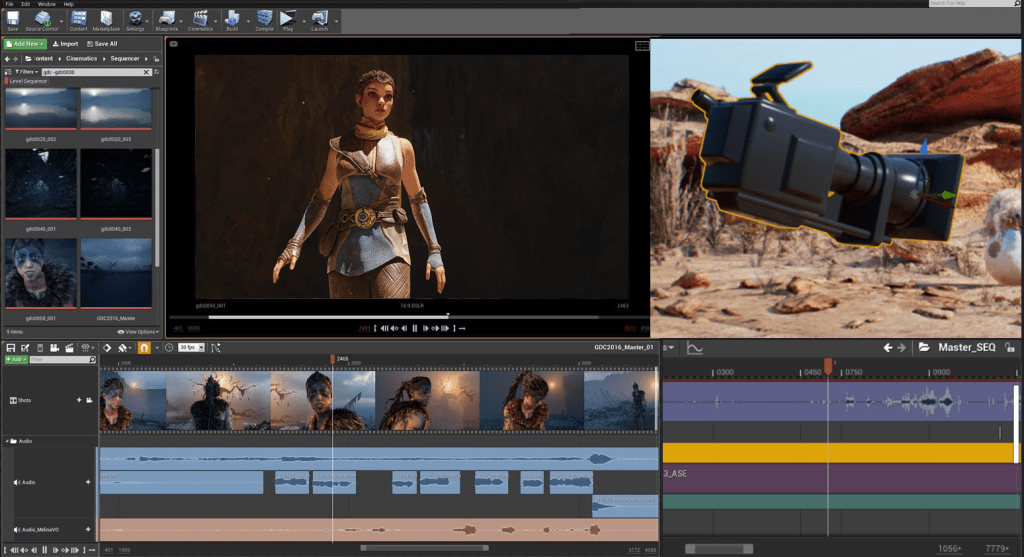When game engines can create moving, walking, talking images this real, it calls into question the entire accepted film-production process. Why spend $100M to finance the filming of a script, and HOPE a good movie comes out of the editing room a year later?
Instead, why not design your movie first, on your computer screen? Then test it and improve it again and again – all still on your computer screen. Then, when it’s perfect, simply go out and shoot what you already know WORKS – with no wasted money or footage on the editing room floor.




This line of thinking opens a door on a new movie production “system” designed to replace the archaic system that Hollywood still uses. Adoption of the system, however, would cascade rapidly into a revolution in filmmaking and cinema worldwide, serviced entirely through a single big-tech platform.
The revolution would have its most visible effects in the quality and “production value” of the movies and shows that we watch. The biggest budget productions (like the Jurassic World and Avengers movies) would become as inexpensive to make as today’s lower end productions. And that changes everything, because if everyone can fill their viewing hours with an endless stream of fresh high-end content, at little or no cost, then demand for less-than-high-end content will dry up overnight (except for nostalgia channels).
And when the highest-end production value becomes accessible to all content-MAKERS, then every content maker on the internet will use it, for video games, ads, websites, social media and new uses that haven’t even been imagined yet.

Creating a new blueprint for Hollywood
The filmmaking industry rests on an archaic production process so unsystematic that it prevents adoption of “new millennium” systems solutions that have transformed other industries.
CineLogic is an alternative production process that shifts the live experimentation of the movie set into a computer simulator. The simulations are 3D-animated and used to blueprint the entire film, frame-for-frame, shot-for-shot and cut-for-cut, precisely as it will unfold on screen. Simulator experimentation slashes costs (not marginally but by orders of magnitude) and decouples the design function from the production function, enhancing both. In other words, when the movie is designed at the beginning of the process instead of at the end, only 8 hours of footage need be shot rather than the usual 300. More importantly, because our crew has an animated blueprint to work from, each hour of filming our way requires only a fraction of the resources required for an hour of conventional filming.



The Problem
The Hollywood movie industry is plagued by two problems – sky-high production cost and unpredictable quality
Filmmaking requires extensive experimentation (exploring the many ways a given screenplay can be portrayed on screen). Though a large portion of this experimentation is done in the editing room, most is conducted on set. Such “live” experimentation in any industry is expensive, but in filmmaking the cost is staggering. What we see as worse, is that live experimentation entangles the design function with the production function, degrading both and violating a fundamental principle of operations management – that design must precede production.
So, the problem in the movie industry is that a movie isn’t really designed until after filming is completed. That’s when the director and editor sift through some 300 hours of footage (enough to make dozens of movies) and (hopefully) design a coherent 2-hour film. In most industries it’s the other way around, in that the end product is designed before the components are produced. CineLogic addresses both problems.
The Solution
A new production system
First, we use the industry’s top game engine, as a simulator, to produce our movie on our computer screen. Next, we test our computer-screen movie, and make a list of all its flaws. Then we go back into the computer simulator and fix every one. Then, we repeat this process, about 150 times … our solution to the quality problem.

What we’re left with is a precision template for our finished film – that includes sets, locations, costumes, music, sound, lighting, lenses, angles, camera movement, dialog, choreography, editing, even the credits – In other words … EVERYTHING!
This precise foreknowledge of every detail of our finished film allows us to then spend our real-world dollars ONLY on actually producing what we already know is going to survive the editing process – which allows us to radically slash the size of our crews, and the amount of footage they need to shoot … our solution to the cost problem.

Our Business Model
Here are the four worst recent losers, in our specific, demographic, budget, genre and sub-genre category:

Yet each of these movies brought in more than $100M in box-office revenue, and then more through cable and streaming. That’s more than most Oscar winners bring in. So, at CineLogic, we like to say “the big-budget-action category doesn’t have a REVENUE problem. It has a COST problem. So, if you had a technology that could deliver big-budget-action at a great enough discount, your worst, worst movies would be modest winners. Your average movies would be big winners, and your good movies would be ridiculous winners.”

Targeting Exponential Growth
One of the many compelling aspects of the CineLogic innovations is how they lead to what scientists call a “feedback loop.”
In our case, the feedback loop is that as more productions join our franchise, the cost of production continues to drop for ALL productions in our franchise. This drop in costs allows more productions to be able to afford to join us, as franchisees – which, in turn, cuts costs again – which, in turn, brings in more productions – and so on.
And the beauty of this math is that there is no point of diminishing return. The cost of the cinematic look, that brings in the most money, keeps getting cheaper and cheaper.

Stay tuned, more to come!